Abstract
Antimicrobial-resistant typhoid fever in Saigon was studied by examining in vitro antimicrobial susceptibilities of Salmonella typhi strains and conducting a randomized clinical trial of ampicillin and trimethoprim-sulfamethoxazole (TMP-SMZ). Isolates of S. typhi were obtained from blood or stool cultures of 90 patients. Of 87 isolates tested for antimicrobial susceptibility, 65 (75%) were resistant (R) to chloramphenicol, streptomycin, sulfonamide, and tetracycline, and 22 (25%) were susceptible (S). The drug resistance was transferable to Escherichia coli and was found in 11 different Vi-phage types. All isolates were susceptible to ampicillin and to TMP-SMZ. Agar dilution studies of TMP and SMZ showed synergistic inhibition of growth in all 18 S isolates and in 12 of 48 R isolates tested. The clinical trial of ampicillin and TMP-SMZ showed that both drugs were equally effective. Treatment failure with both drugs was more frequent in patients with S isolates than in patients with R isolates. Therefore, in an area where antimicrobial-resistant typhoid fever exists, patients with R isolates should receive either ampicillin or TMP-SMZ, but patients with S isolates should be treated with chloramphenicol.
Full text
PDF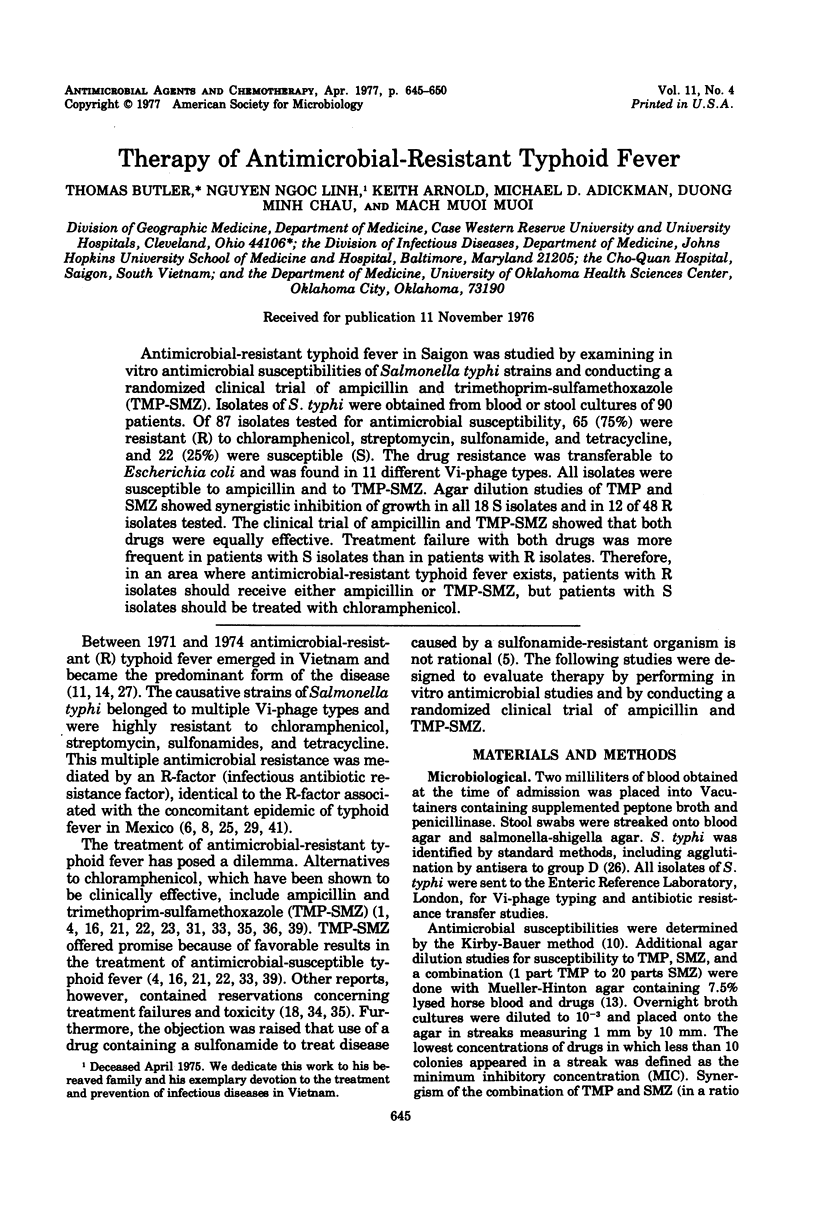
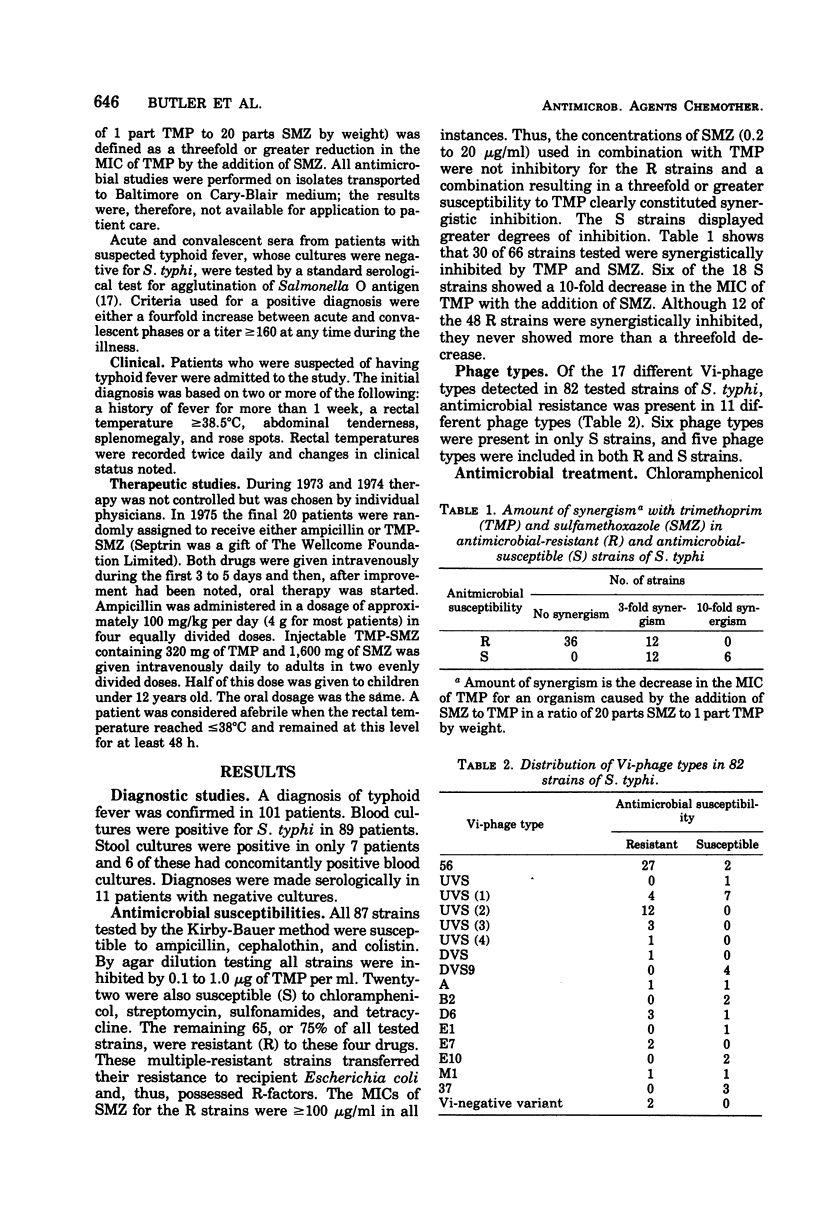
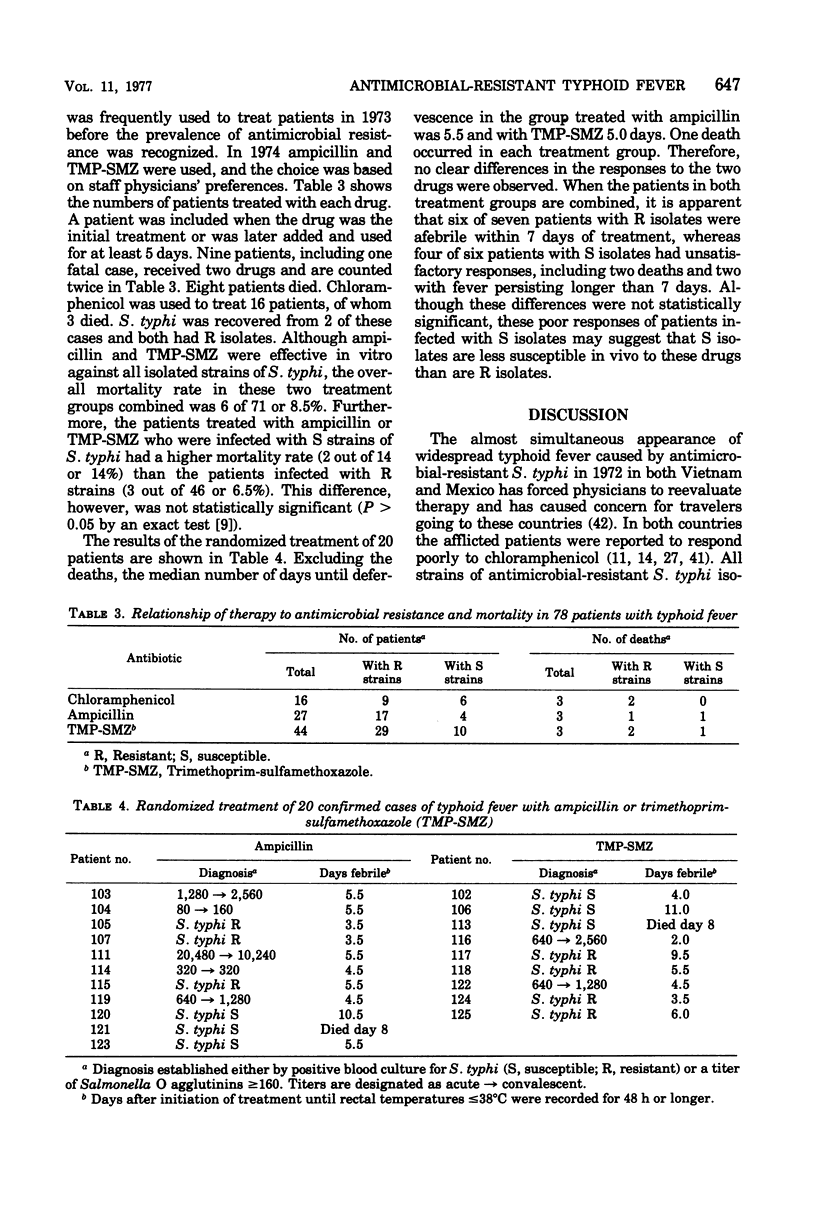
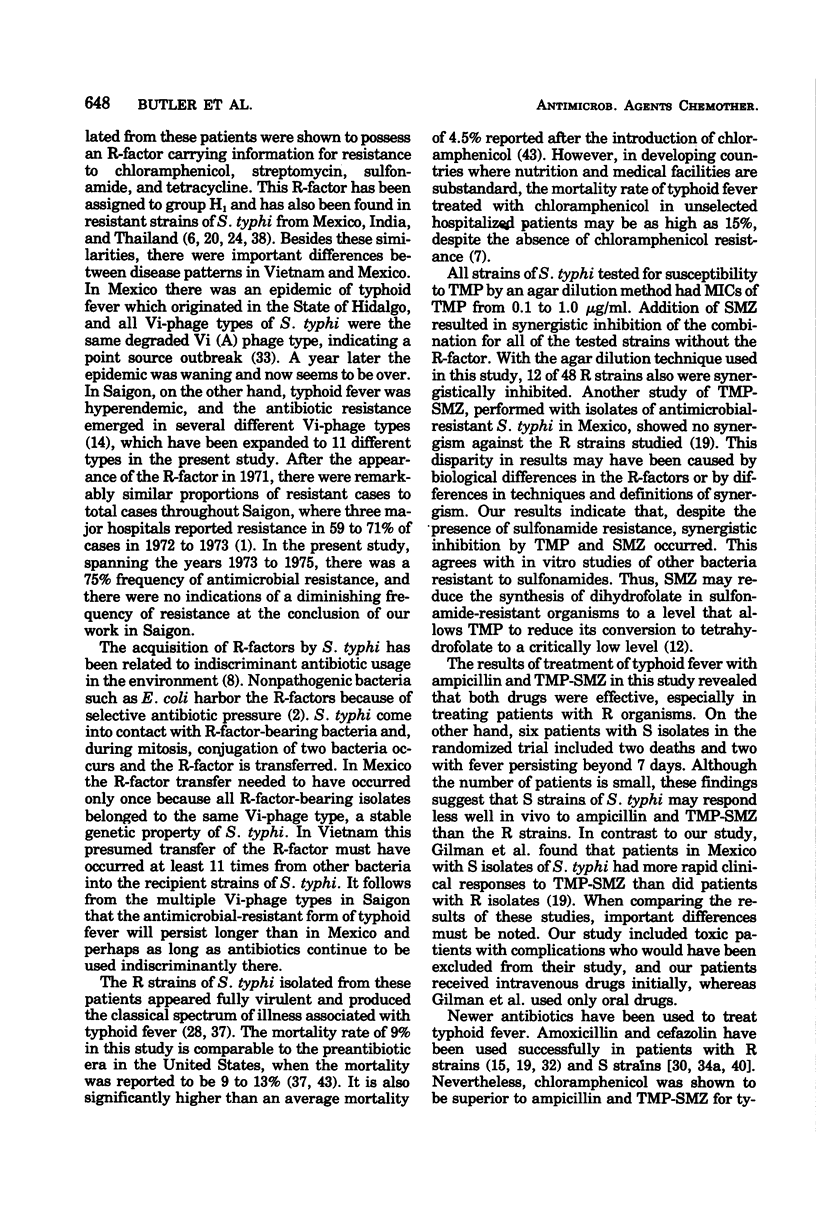
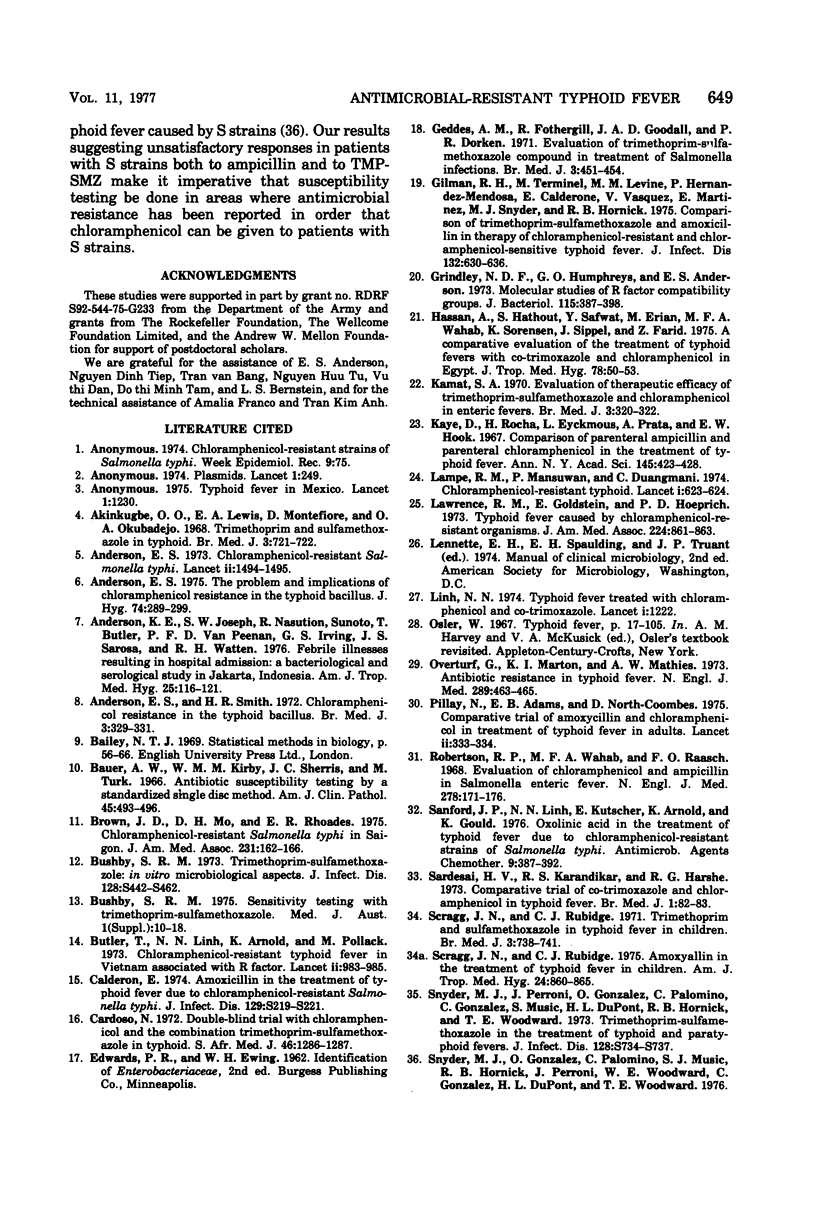
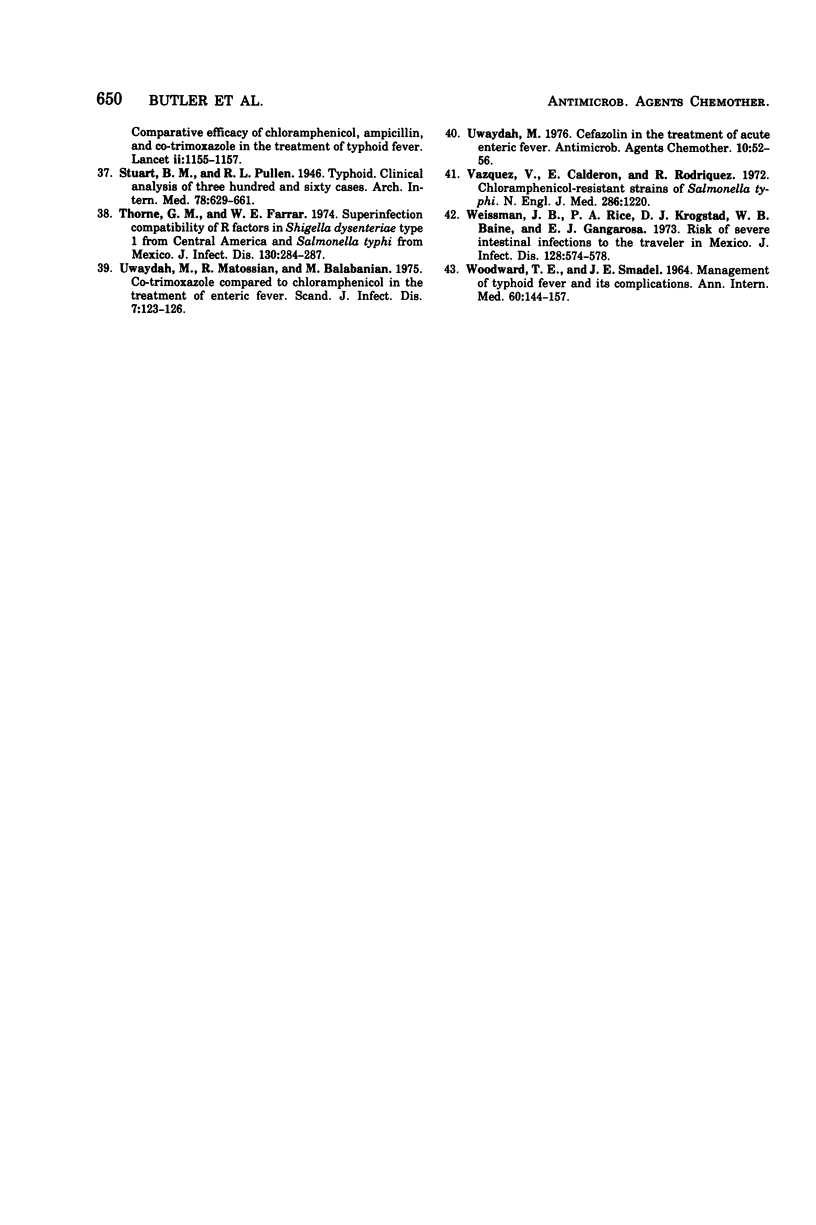
Selected References
These references are in PubMed. This may not be the complete list of references from this article.
- Akinkugbe O. O., Lewis E. A., Montefiore D., Okubadejo O. A. Trimethoprim and sulphamethoxazole in typhoid. Br Med J. 1968 Sep 21;3(5620):721–722. doi: 10.1136/bmj.3.5620.721. [DOI] [PMC free article] [PubMed] [Google Scholar]
- Anderson E. S., Smith H. R. Chloramphenicol resistance in the typhoid bacillus. Br Med J. 1972 Aug 5;3(5822):329–331. doi: 10.1136/bmj.3.5822.329. [DOI] [PMC free article] [PubMed] [Google Scholar]
- Anderson E. S. The problem and implications of chloramphenicol resistance in the typhoid bacillus. J Hyg (Lond) 1975 Apr;74(2):289–299. doi: 10.1017/s0022172400024360. [DOI] [PMC free article] [PubMed] [Google Scholar]
- Anderson K. E., Joseph S. W., Nasution R., Sunoto, Butler T., Van Peenen P. F., Irving G. S., Saroso J. S., Watten R. H. Febrile illnesses resulting in hospital admission: a bacteriological and serological study in Jakarta, Indonesia. Am J Trop Med Hyg. 1976 Jan;25(1):116–121. doi: 10.4269/ajtmh.1976.25.116. [DOI] [PubMed] [Google Scholar]
- Bauer A. W., Kirby W. M., Sherris J. C., Turck M. Antibiotic susceptibility testing by a standardized single disk method. Am J Clin Pathol. 1966 Apr;45(4):493–496. [PubMed] [Google Scholar]
- Brown J. D., Duong Hong M. o., Rhoades E. R. Chloramphenicol-resistant Salmonella typhi in Saigon. JAMA. 1975 Jan 13;231(2):162–166. [PubMed] [Google Scholar]
- Butler T., Linh N. N., Arnold K., Pollack M. Chloramphenicol-resistant typhoid fever in Vietnam associated with R factor. Lancet. 1973 Nov 3;302(7836):983–985. doi: 10.1016/s0140-6736(73)91086-6. [DOI] [PubMed] [Google Scholar]
- Calderon E. Amoxicillin in the treatment of typhoid fever due to chloramphenicol-resistance Salmonella typhi. J Infect Dis. 1974 Jun;129(0):suppl–suppl:S221. doi: 10.1093/infdis/129.supplement_2.s219. [DOI] [PubMed] [Google Scholar]
- Cardoso N. Double-blind trial with chloramphenicol and the combination trimethoprim-sulfamethoxazole in typhoid. S Afr Med J. 1972 Sep 9;46(36):1286–1287. [PubMed] [Google Scholar]
- Geddes A. M., Fothergill R., Goodall J. A., Dorken P. R. Evaluation of trimethoprim-sulphamethoxazole compound in treatment of salmonella infections. Br Med J. 1971 Aug;3(5772):451–454. doi: 10.1136/bmj.3.5772.451. [DOI] [PMC free article] [PubMed] [Google Scholar]
- Gilman R. H., Terminel M., Levine M. M., Hernandez-Mendosa P., Calderone E., Vasquez V., Martinez E., Snyder M. J., Hornick R. B. Comparison of trimethoprim-sulfamethoxazole and amoxicillin in therapy of chloramphenicol-resistant and chloramphenicol-sensitive typhoid fever. J Infect Dis. 1975 Dec;132(6):630–636. doi: 10.1093/infdis/132.6.630. [DOI] [PubMed] [Google Scholar]
- Grindley N. D., Humphreys G. O., Anderson E. S. Molecular studies of R factor compatibility groups. J Bacteriol. 1973 Jul;115(1):387–398. doi: 10.1128/jb.115.1.387-398.1973. [DOI] [PMC free article] [PubMed] [Google Scholar]
- Hassan A., Hathout S., Safwat Y., Erian M., Wahab M. F., Sorensen K., Sippel J., Farid Z. A comparative evaluation of the treatment of typhoid fevers with co-trimoxazole and chloramphenicol in Egypt. J Trop Med Hyg. 1975 Mar;78(3):50–53. [PubMed] [Google Scholar]
- Kamat S. A. Evaluation of therapeutic efficacy of trimethoprim-sulphamethoxazole and chloramphenicol in enteric fever. Br Med J. 1970 Aug 8;3(5718):320–322. doi: 10.1136/bmj.3.5718.320. [DOI] [PMC free article] [PubMed] [Google Scholar]
- Kaye D., Eyckmans L., Rocha H., Prata A., Hook E. W. Comparison of parenteral ampicillin and parenteral chloramphenicol in the treatment of typhoid fever. Ann N Y Acad Sci. 1967 Sep 27;145(2):423–428. doi: 10.1111/j.1749-6632.1967.tb50241.x. [DOI] [PubMed] [Google Scholar]
- Lampe R. M., Mansuwan P., Duangmani C. Letter: Chloramphenicol--resistant typhoid. Lancet. 1974 Apr 6;1(7858):623–624. doi: 10.1016/s0140-6736(74)92678-6. [DOI] [PubMed] [Google Scholar]
- Lawrence R. M., Goldstein E., Hoeprich P. D. Typhoid fever caused by chloramphenicol-resistant organisms. JAMA. 1973 May 7;224(6):861–863. [PubMed] [Google Scholar]
- Nguyen Ngoc Linh Letter: Typhoid fever treated with chloramphenicol and co-trimoxazole. Lancet. 1974 Jun 15;1(7868):1222–1222. doi: 10.1016/s0140-6736(74)91025-3. [DOI] [PubMed] [Google Scholar]
- Overturf G., Marton K. I., Mathies A. W., Jr Antibiotic resistance in typhoid fever. Chloramphenicol resistance among clinical isolates of Salmonella typhosa in Los Angeles, 1972--epidemiologic and bacteriologic characteristics. N Engl J Med. 1973 Aug 30;289(9):463–465. doi: 10.1056/NEJM197308302890906. [DOI] [PubMed] [Google Scholar]
- Pillay N., Adams E. B., North-Coombes D. Comparative trial of amoxycillin and chloramphenicol in treatment of typhoid fever in adults. Lancet. 1975 Aug 23;2(7930):333–334. doi: 10.1016/s0140-6736(75)92776-2. [DOI] [PubMed] [Google Scholar]
- Robertson R. P., Wahab M. F., Raasch F. O. Evaluation of chloramphenicol and ampicillin in salmonella enteric fever. N Engl J Med. 1968 Jan 25;278(4):171–176. doi: 10.1056/NEJM196801252780401. [DOI] [PubMed] [Google Scholar]
- Sanford J. P., Linh N. N., Kutscher E., Arnold K., Gould K. Oxolinic acid in the treatment of typhoid fever due to chloramphenicol-resistant strains of Salmonella typhi. Antimicrob Agents Chemother. 1976 Mar;9(3):387–392. doi: 10.1128/aac.9.3.387. [DOI] [PMC free article] [PubMed] [Google Scholar]
- Sardesai H. V., Karandikar R. S., Harshe R. G. Comparative trial of Co-trimoxazole and Chloramphenicol in Typhoid Fever. Br Med J. 1973 Jan 13;1(5845):82–83. doi: 10.1136/bmj.1.5845.82. [DOI] [PMC free article] [PubMed] [Google Scholar]
- Scragg J. N., Rubidge C. J. Amoxycillin in the treatment of typhoid fever in children. Am J Trop Med Hyg. 1975 Sep;24(5):860–865. doi: 10.4269/ajtmh.1975.24.860. [DOI] [PubMed] [Google Scholar]
- Scragg J. N., Rubidge C. J. Trimethoprim and sulphamethoxazole in typhoid fever in children. Br Med J. 1971 Sep 25;3(5777):738–741. doi: 10.1136/bmj.3.5777.738. [DOI] [PMC free article] [PubMed] [Google Scholar]
- Thorne G. M., Farrar W. E., Jr Superinfection compatibility of R factors in Shigella dysenteriae type 1 from Central America and Salmonella typhi from Mexico. J Infect Dis. 1974 Sep;130(3):284–287. doi: 10.1093/infdis/130.3.284. [DOI] [PubMed] [Google Scholar]
- Uwaydah M. Cefazolin in the treatment of acute enteric fever. Antimicrob Agents Chemother. 1976 Jul;10(1):52–56. doi: 10.1128/aac.10.1.52. [DOI] [PMC free article] [PubMed] [Google Scholar]
- Uwaydah M., Matossian R., Balabanian M. Co-trimoxazole compared to chloramphenicol in the treatment of enteric fever. Scand J Infect Dis. 1975;7(2):123–126. doi: 10.3109/inf.1975.7.issue-2.08. [DOI] [PubMed] [Google Scholar]
- Vázquez V., Calderón E., Rodríquez R. S. Chloramphenicol-resistant strains of Salmonella typhosa. N Engl J Med. 1972 Jun 1;286(22):1220–1220. [PubMed] [Google Scholar]
- WOODWARD T. E., SMADEL J. E. MANAGEMENT OF TYPHOID FEVER AND ITS COMPLICATIONS. Ann Intern Med. 1964 Jan;60:144–157. doi: 10.7326/0003-4819-60-1-144. [DOI] [PubMed] [Google Scholar]
- Weissman J. B., Rice P. A., Krogstad D. J., Baine W. B., Gangarosa E. J. Risk of severe intestinal infection to the traveler in Mexico. J Infect Dis. 1973 Oct;128(4):574–577. doi: 10.1093/infdis/128.4.574. [DOI] [PubMed] [Google Scholar]


